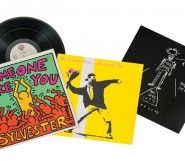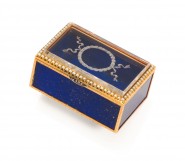Lot #31 - Ronnie Tjampitjinpa
-
Auction House:Deutscher and Hackett
-
Sale Name:Aboriginal Art from the Luczo Family Collection, USA
-
Sale Date:19 Oct 2016 ~ 7pm
-
Lot #:31
-
Lot Description:Ronnie Tjampitjinpa
born c.1943
The Kadaitcha Man, 1993
synthetic polymer paint on linen
121.0 x 61.0 cm
bears inscription verso: Papunya Tula Artists cat. RT930437 -
Provenance:Painted at Kintore in April 1993; Papunya Tula Artists, Alice Springs ; Private collection, Darwin; Sotheby's, Melbourne, 31 July 2006, lot 104; The Luczo Family Collection, USA
-
Exhibited:On long term loan and exhibition at The Supreme Court of the Northern Territory, Darwin between 1993 and 2006
-
References:Related Work: Untitled, 1994, in the collection of the Art Gallery of New South Wales, illus. in Perkins, H. ,and Fink, H. (eds), Papunya Tula: Genesis and Genius, Art Gallery of New South Wales in association with Papunya Tula Artists, Sydney, 2000, p. 127
-
Notes:This painting is accompanied by a certificate of authenticity from Papunya Tula Artists that states in part: ‘This painting depicts a Kadaitcha Man (ritual killer) who lived in the vicinity of Marputrri to the south of Lake Mackay. He is said to be a young man who moves around this area.’ Signifying ‘a malignant spirit… a man who has either been formally selected or goes out on his own initiative on a mission of vengeance against some individual accused of injuring someone by magic’,1 the term Kadaitcha is used colloquially among diverse language groups in Central Australia to describe a ritual killer. The origins of the word are surrounded in mystery, appropriately perhaps, because the modus operandi of the Kadaitcha is intentionally secret. Some regard the word Kadaitcha as being of Arrernte origin, while others suggest a more distant source, with the term first appearing in correspondence from the Colonial frontier in the late 1800s. It is important when interpreting The Kadaitcha Man, 1993, to note that the artist applies the title in the Pintupi vernacular sense. It is intended to convey something fearful about the behavior of a particular young man who carried out his lethal business at Marputrri, to the south of Lake Mackay. Therefore some aspects of the behavior of Kadaitcha (or ‘featherfoot’) described in the literature may not apply to this particular individual. A more relevant explanation of the liminal presence of malignant spirits in the region can be found in Hinkson’s accounts of jarnpa in neighboring Warlpiri country. Larry Jungarrayi, Jarnpa, 1953-4, in the collection of the Australian Institute of Aboriginal and Torres Strait Islander Studies, also transports the terrifying image of this ‘demon’ into our gaze.2 Ronnie Tjampitjinpa’s full frontal evocation of the killer is all the more chilling for its simplicity. The killer’s head is shown as a set of expanding concentric circles, from which bands of power emanate into the landscape beyond the canvas. The body is suspended in the same bands, emphasising the apparent weightless by which ritual killers can approach their victims without notice, and escape without trace. In 1971, Tjampitjinpa participated in the first flowering of contemporary desert art at Papunya under the tutelage of his classificatory father, UtaUtaTjangala. In the early 1980s, when he returned to live on the land of his birth, Tjampitjinpa’s uncompromising creative character emerged. From that time his painting gained force, with broad bands of contrasting tones pressing hard at the perimeters of the rectangular format on which he painted. The bravura and physical presence of this composition discloses Tjampitjinpa as the most masculine and assertive of Pintupi painters. Tjampitjinpa’s paintings perfectly express his personal, political and ritual presence in the Pintupi homelands; he is unashamedly ‘the boss for his own country’. JOHN KEAN 1. Dixon, R. M., et al. Australian Aboriginal Words in English: their Origin and Meaning, Oxford University Press, Melbourne, 1990, p. 156; 2. Hinkson, M., Remembering the Future: Warlpiri Life through the Prism of Drawing, Aboriginal Studies Press, Canberra, 2014
-
Estimate:A$12,000 - 15,000
-
Realised Price:
-
Category:Art
This Sale has been held and this item is no longer available. Details are provided for information purposes only.










